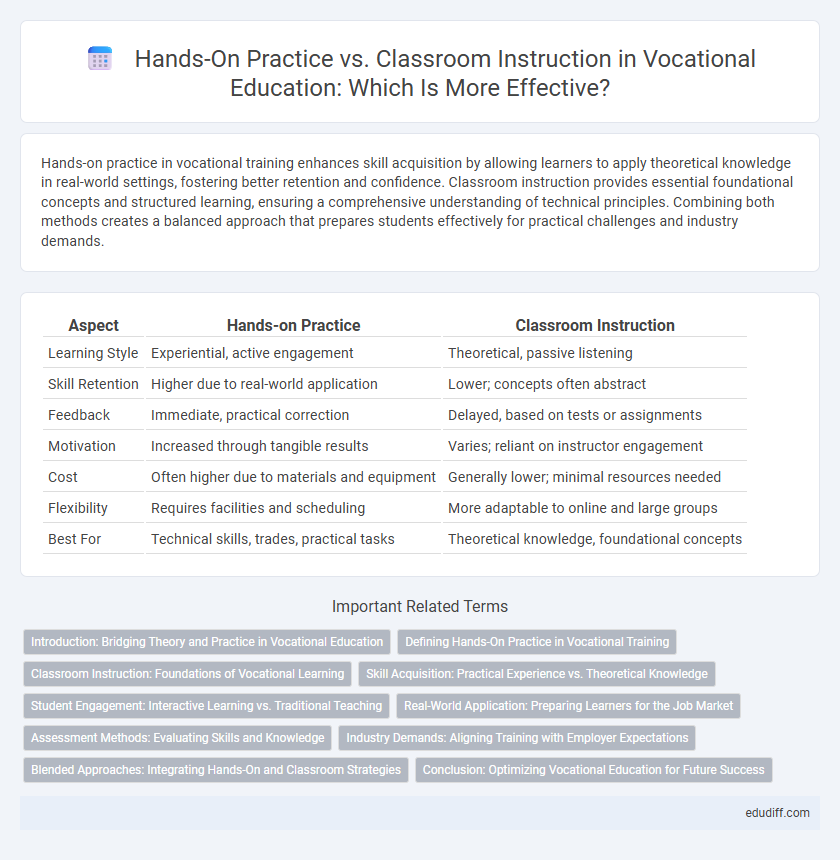Hands-on practice in vocational training enhances skill acquisition by allowing learners to apply theoretical knowledge in real-world settings, fostering better retention and confidence. Classroom instruction provides essential foundational concepts and structured learning, ensuring a comprehensive understanding of technical principles. Combining both methods creates a balanced approach that prepares students effectively for practical challenges and industry demands.
Table of Comparison
| Aspect | Hands-on Practice | Classroom Instruction |
|---|---|---|
| Learning Style | Experiential, active engagement | Theoretical, passive listening |
| Skill Retention | Higher due to real-world application | Lower; concepts often abstract |
| Feedback | Immediate, practical correction | Delayed, based on tests or assignments |
| Motivation | Increased through tangible results | Varies; reliant on instructor engagement |
| Cost | Often higher due to materials and equipment | Generally lower; minimal resources needed |
| Flexibility | Requires facilities and scheduling | More adaptable to online and large groups |
| Best For | Technical skills, trades, practical tasks | Theoretical knowledge, foundational concepts |
Introduction: Bridging Theory and Practice in Vocational Education
Hands-on practice in vocational education solidifies theoretical knowledge by enabling students to apply concepts in real-world settings, enhancing skill retention and job readiness. Classroom instruction provides essential foundational understanding of principles, safety protocols, and technical terminology critical for effective practical application. Integrating hands-on experience with classroom learning ensures a comprehensive approach that prepares students for industry demands and evolving vocational challenges.
Defining Hands-On Practice in Vocational Training
Hands-on practice in vocational training emphasizes active participation and real-world application of skills essential for specific trades, such as welding, carpentry, or electrical work. This approach enables learners to develop practical competencies by working directly with tools, equipment, and materials in authentic or simulated work environments. Training programs incorporating hands-on practice increase job readiness and enhance skill retention compared to purely theoretical classroom instruction.
Classroom Instruction: Foundations of Vocational Learning
Classroom instruction lays the foundational knowledge essential for vocational learning by providing structured curricula and theoretical frameworks that guide practical applications. It integrates key concepts, safety protocols, and industry standards, enabling learners to develop critical thinking and problem-solving skills before engaging in hands-on practice. This foundational learning environment fosters a comprehensive understanding that enhances skill acquisition and prepares students for real-world vocational challenges.
Skill Acquisition: Practical Experience vs. Theoretical Knowledge
Hands-on practice accelerates skill acquisition by providing real-world scenarios that enhance practical experience, crucial for mastering vocational tasks. Classroom instruction delivers foundational theoretical knowledge essential for understanding principles and frameworks underlying technical skills. Balancing practical experience with theoretical learning ensures comprehensive vocational competence and improved job readiness.
Student Engagement: Interactive Learning vs. Traditional Teaching
Hands-on practice enhances student engagement by actively involving learners in real-world tasks, promoting skill retention and critical thinking. Interactive learning environments encourage collaboration and immediate feedback, contrasting with traditional classroom instruction that often relies on passive listening. Vocational education benefits from blending experiential activities with theoretical knowledge to maximize learner motivation and competency development.
Real-World Application: Preparing Learners for the Job Market
Hands-on practice enhances skill acquisition by immersing learners in realistic work scenarios, enabling mastery of tools and techniques essential for the vocational job market. Classroom instruction provides foundational theories and structured knowledge but often lacks immediate applicability to dynamic work environments. Integrating practical experiences with theoretical learning maximizes job readiness, equipping students with both conceptual understanding and real-world problem-solving capabilities.
Assessment Methods: Evaluating Skills and Knowledge
Assessment methods in vocational training emphasize practical evaluations to measure hands-on skills, ensuring learners demonstrate proficiency through real-world tasks rather than solely theoretical exams. Simulated work environments and performance-based assessments provide concrete evidence of competence by replicating industry-specific challenges. Combining practical demonstrations with targeted knowledge tests creates a comprehensive evaluation framework that accurately reflects a learner's readiness for job roles.
Industry Demands: Aligning Training with Employer Expectations
Vocational training that emphasizes hands-on practice directly addresses industry demands by equipping learners with practical skills employers seek, enhancing job readiness and productivity. Classroom instruction provides essential theoretical knowledge, but integrating real-world applications ensures alignment with current workplace technologies and standards. Aligning training programs with employer expectations through experiential learning reduces skill gaps and accelerates workforce integration.
Blended Approaches: Integrating Hands-On and Classroom Strategies
Blended approaches in vocational training combine hands-on practice with classroom instruction to enhance skill acquisition and knowledge retention. Integrating practical exercises with theoretical learning provides learners with real-world application and deeper understanding of complex concepts. Research shows that students engaged in blended learning demonstrate higher competency and job readiness compared to those who rely solely on traditional classroom methods.
Conclusion: Optimizing Vocational Education for Future Success
Hands-on practice in vocational education significantly enhances skill retention and real-world application compared to traditional classroom instruction. Integrating experiential learning with theoretical knowledge creates a balanced curriculum that meets industry demands and boosts employability. Prioritizing hands-on training alongside classroom instruction optimizes vocational education outcomes for future career success.
Hands-on practice vs Classroom instruction Infographic

 edudiff.com
edudiff.com